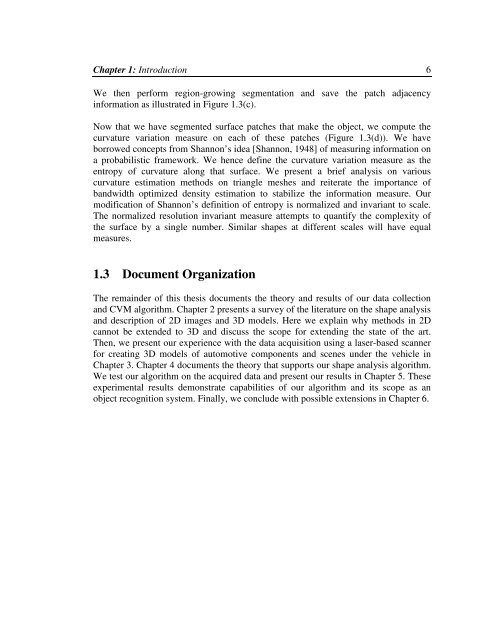To the Graduate Council: I am submitting herewith a thesis written by ...
To the Graduate Council: I am submitting herewith a thesis written by ...
To the Graduate Council: I am submitting herewith a thesis written by ...
You also want an ePaper? Increase the reach of your titles
YUMPU automatically turns print PDFs into web optimized ePapers that Google loves.
Chapter 1: Introduction 6We <strong>the</strong>n perform region-growing segmentation and save <strong>the</strong> patch adjacencyinformation as illustrated in Figure 1.3(c).Now that we have segmented surface patches that make <strong>the</strong> object, we compute <strong>the</strong>curvature variation measure on each of <strong>the</strong>se patches (Figure 1.3(d)). We haveborrowed concepts from Shannon’s idea [Shannon, 1948] of measuring information ona probabilistic fr<strong>am</strong>ework. We hence define <strong>the</strong> curvature variation measure as <strong>the</strong>entropy of curvature along that surface. We present a brief analysis on variouscurvature estimation methods on triangle meshes and reiterate <strong>the</strong> importance ofbandwidth optimized density estimation to stabilize <strong>the</strong> information measure. Ourmodification of Shannon’s definition of entropy is normalized and invariant to scale.The normalized resolution invariant measure attempts to quantify <strong>the</strong> complexity of<strong>the</strong> surface <strong>by</strong> a single number. Similar shapes at different scales will have equalmeasures.1.3 Document OrganizationThe remainder of this <strong>the</strong>sis documents <strong>the</strong> <strong>the</strong>ory and results of our data collectionand CVM algorithm. Chapter 2 presents a survey of <strong>the</strong> literature on <strong>the</strong> shape analysisand description of 2D images and 3D models. Here we explain why methods in 2Dcannot be extended to 3D and discuss <strong>the</strong> scope for extending <strong>the</strong> state of <strong>the</strong> art.Then, we present our experience with <strong>the</strong> data acquisition using a laser-based scannerfor creating 3D models of automotive components and scenes under <strong>the</strong> vehicle inChapter 3. Chapter 4 documents <strong>the</strong> <strong>the</strong>ory that supports our shape analysis algorithm.We test our algorithm on <strong>the</strong> acquired data and present our results in Chapter 5. Theseexperimental results demonstrate capabilities of our algorithm and its scope as anobject recognition system. Finally, we conclude with possible extensions in Chapter 6.
















